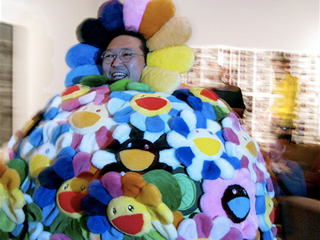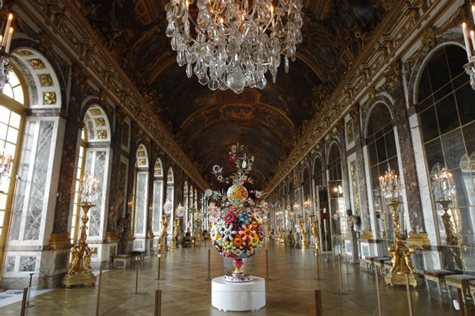Human Flower Project
Murakami Arouses Versailles
A Japanese pop-artist sends 50 squeals of comedy and commercialism through the palace of the king.

Artist Takashi Murakami dressed as his sculpture “Flower Matango” at Miami’s Art Basel, Dec. 2008
Photo: via Hypebeast
“Don’t touch my palace,” a group shouted outside the Château de Versailles on Tuesday.
The gathering, only about 20 strong but with a petition of some 5300 names in support, had come to protest an exhibit of Japanese artist Takashi Murakami that just opened inside the former palace of France’s King Louis XIV.
Fifty of Murakami’s sculptures have been installed in the rooms, hallways and gardens of the palace. Curators solicited these pieces with their plastic-easter-egg colors and cartoon imagery as a blast of pop, their humor and grandiose-triviality a wonderful counterpoint to all that heavy history and regal authority.
We were, of course, especially enchanted by Murakami’s Flower Matango, an immense bulb of floral smily-faces balanced on a pedestal and sprouting vine-like appendages. The piece looks especially striking here, wriggling its limbs into the stratosphere of Le Roi Soleil’s Hall of Mirrors. In fact, from what photographs can convey, Versailles’ setting does wonders for Flower Matango. In other installations, like this sensurround of Murakami-ana (right down to the wallpaper), the sculpture seems to disappear; the art of it falls asleep inside a thumb-sucking nursery.

Murakami’s Flower Matango shown at the artist’s Brooklyn retrospective
Photo: via Design Sigh
But in the palace of the king, the wonder and strangeness of Murakami’s work – and its giddy artificiality – come to life.
And so does the palace itself. We think this is what the curators had in mind. If you’ve ever visited Versailles, you may, like us, have been deadened by its unrelenting classicism. Tramping across acres of evergreens clipped into symmetrical brocade or looking up into yet another baroque daybreak across the ceiling, one grows strangely bored as a grasshopper might grow bored on a Persian carpet. The bathos of Superpower.
When a Congressman can, with impunity, yell at the president “You lie!,” a total environment like this one, designed to convey not just royalty but divinity, is incomprehensible, vaguely ridiculous. Only next to something more blatantly ridiculous does the stateliness of of the palace come into view again. Murakami’s art keeps the beauty of Versailles from disappearing. Next to his fiberglass sculptures, the color of Good and Plenty candy, the 17th century chandeliers sparkle with greater radiance and the shadows of all those giant paintings deepen.

“Flower Manago” in the Hall of Mirrors, Chateau de Versailles
Photo: via planet ark
We’re reminded of another Frenchman, Pierre Bourdieu, whose own oeuvre was a palace of insights about human culture. In The Field of Cultural Production, he writes that each system of human culture – art and “world heritage” surely qualify—is “not the product of a coherence-seeking intention or an objective consensus…but the product and prize of a permanent conflict; or, to put it another way, that the generative unifying principle of this ‘system’ is the struggle, with all the contradictions it engenders.” That there would be protestors, even as few as 20, standing outside the Palace of Versailles shouting in opposition proves how wise the curators were to invite Asia’s “king” of superflat inside.
Only the ghost of King Louis XIV knows how much conflict went into financing, building, and maintaining Versailles. “Struggle” was not his problem. But it is the problem of those who would keep his palace culturally alive in 2010.
As for the hands-off advocates who showed up on Tuesday, more power to them. Despite what they say, direct-action and public demonstration are about as “touchy” as you get.

